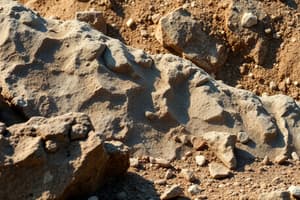Podcast
Questions and Answers
What is the correct order of steps in the scientific method?
What is the correct order of steps in the scientific method?
- Hypothesis, Experiment, Conclusion, Observation
- Observation, Hypothesis, Experiment, Conclusion (correct)
- Conclusion, Observation, Experiment, Hypothesis
- Experiment, Hypothesis, Observation, Conclusion
Which of the following correctly identifies one of Earth's spheres?
Which of the following correctly identifies one of Earth's spheres?
- The Biosphere only refers to terrestrial ecosystems.
- The Geosphere encompasses all water bodies on Earth.
- The Hydrosphere includes all the water found on Earth. (correct)
- The Atmosphere is the layer of Earth beneath the surface.
Which practice is NOT recommended for lab safety?
Which practice is NOT recommended for lab safety?
- Wearing goggles when handling chemicals
- Keeping work areas tidy
- Following instructions carefully
- Eating and drinking in the lab (correct)
Which sphere of Earth includes living organisms?
Which sphere of Earth includes living organisms?
What should you do first if a chemical spill occurs in the lab?
What should you do first if a chemical spill occurs in the lab?
What role does hypothesis testing play in the scientific method?
What role does hypothesis testing play in the scientific method?
Why is it important to control variables during an experiment?
Why is it important to control variables during an experiment?
What is the significance of peer review in scientific research?
What is the significance of peer review in scientific research?
What is the purpose of drawing conclusions in the scientific method?
What is the purpose of drawing conclusions in the scientific method?
Which statement best represents the nature of scientific knowledge?
Which statement best represents the nature of scientific knowledge?
Flashcards are hidden until you start studying
Study Notes
Scientific Method
- A systematic approach used to explore observations and answer questions.
- Steps include:
- Observation: Gathering information and noticing patterns.
- Question: Formulating a question based on observations.
- Hypothesis: Proposing a testable explanation or prediction.
- Experiment: Designing and conducting experiments to test the hypothesis.
- Analysis: Interpreting the data collected during experiments.
- Conclusion: Summarizing findings and determining whether the hypothesis is supported.
Earth's Spheres
- The Earth is composed of four major systems:
- Atmosphere: Layers of gases surrounding Earth; responsible for weather and climate.
- Lithosphere: The solid outer part of the Earth, including rocks and soil, plays a crucial role in ecosystems.
- Hydrosphere: All water on Earth, including oceans, rivers, lakes, and groundwater; essential for life.
- Biosphere: The zone of life on Earth; encompasses all living organisms and their interactions.
Lab Safety
- Importance of safety protocols in the laboratory to prevent accidents and ensure a safe learning environment.
- Key safety practices:
- Personal Protective Equipment (PPE): Use of goggles, gloves, and lab coats to protect against harmful substances.
- Emergency Procedures: Familiarity with the location of safety equipment like fire extinguishers, eye wash stations, and first aid kits.
- Chemical Handling: Proper techniques for handling and disposing of chemicals to prevent spills and exposure.
- Equipment Use: Following guidelines for operating laboratory equipment to avoid injuries.
Studying That Suits You
Use AI to generate personalized quizzes and flashcards to suit your learning preferences.




